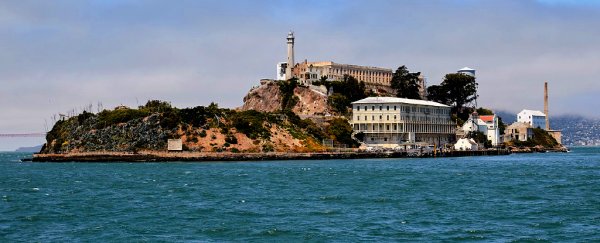Alcatraz has a pretty well stocked history.
The relatively small island has been home to an important lighthouse, become a military fortification, and eventually a prison to hold the likes of Al Capone and George "Machine Gun" Kelly. It was occupied by 'Indians of All Tribes' in the 1960's and today is a huge tourist attraction.
Through these reinventions, many of its old skins have been lost through the years as Alcatraz gets a new concrete layer and takes on a new role.
But researchers have discovered something amazing under one of those layers on the small island - tunnels and buildings dating back to the American Civil War.
"I was surprised for several reasons," said one of the researchers, Binghamton University archaeologist Timothy de Smet.
"The remains of these historical archaeology features were just a few centimetres beneath the surface and they were miraculously and impeccably preserved. The concrete veneer of the Recreation Yard floor is incredibly thin and, in fact, in places sitting directly atop the architecture from the 1860s."
The team didn't actually go digging up the historic landmark – instead they used ground-penetrating radar, laser scans of the area, and analysed old maps from the time period to peer under the metaphorical hood.
"We also learned that some of the earthwork traverses were covered over with thin concrete layers through time, likely to decrease erosion on the rainy windy island," de Smet explains.
"It was wonderful to find the history just beneath our feet that we can visualise for the public."
So what exactly did they find?
"Remnants of buried structures including a 'bombproof' earthwork traverse and its underlying vaulted brick masonry tunnel and ventilation ducts were discovered to run east-west beneath the recreation yard," the team writes in their paper.
"Alcatraz is less known in its former military role as a 19th century coastal fortification protecting the interests of a rapidly westward-expanding nation during the turbulent era of Manifest Destiny, the 1849 Gold Rush and the Civil War."
These hidden tunnels and rooms are all that's left of the military base on the 20 hectare (50 acre) island, a facility built to keep San Francisco safe from invasion.
Although historians had some idea of what had existed before the prison thanks to historical documents and limited artefacts, this study gives decisive details of what was actually there, shedding light on a part of Alcatraz that was relatively unstudied.
"This really reinforces what several historians and archaeologists had long suspected," said one of the researchers and Alcatraz historian John Martini to PBS. "Up until this point, we had nothing to go on except for a few visible trace remains and maps - and a lot of suspicion."
"On a small island, there's only so many places you can build."
The team thinks that these techniques could be used on other cultural landmarks across the world, with the added bonus that you won't damage the historical structures.
"With modern remote sensing methods like these, we can answer fundamental archaeological research questions about human behaviour, social organisation and cultural change through time without costly and destructive excavation," says de Smet.
"These results are significant in that they show how modern technology can be used to answer fundamental questions of archaeological importance."
The research has been published in Near Surface Geophysics.
